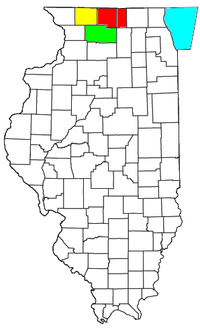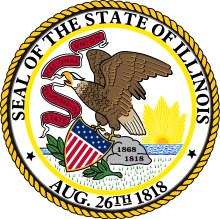Rockford metropolitan area, Illinois
The Rockford Metropolitan Statistical Area, as defined by the United States Census Bureau, is an area consisting of four counties in north-central Illinois, anchored by the city of Rockford. As of the 2010 census, the MSA had a population of 349,431 (though a 2011 estimate placed the population at 348,360).[1] The Rockford MSA is adjacent to the Janesville-Beloit MSA and the Chicago MSA. It forms the main part of the larger Rockford–Freeport–Rochelle Combined Statistical Area (est. pop. 455,595).

Counties
Communities
- Places with more than 150,000 inhabitants
- Rockford (Principal City)
- Places with 20,000 to 30,000 inhabitants
- Places with 5,000 to 20,000 inhabitants
- Places with 1,000 to 5,000 inhabitants
- Places with less than 1,000 inhabitants
- Unincorporated places
Townships
Demographics
| Historical population | |||
|---|---|---|---|
| Census | Pop. | %± | |
| 1900 | 47,845 | — | |
| 1910 | 63,153 | 32.0% | |
| 1920 | 90,929 | 44.0% | |
| 1930 | 117,373 | 29.1% | |
| 1940 | 121,178 | 3.2% | |
| 1950 | 152,385 | 25.8% | |
| 1960 | 230,091 | 51.0% | |
| 1970 | 272,063 | 18.2% | |
| 1980 | 279,514 | 2.7% | |
| 1990 | 283,719 | 1.5% | |
| 2000 | 320,204 | 12.9% | |
| 2010 | 349,431 | 9.1% | |
| Est. 2018 | 337,658 | −3.4% | |
| U.S. Decennial Census[2] | |||
As of the census[3] of 2000, there were 320,204 people, 122,577 households, and 84,896 families residing within the MSA. The racial makeup of the MSA was 83.46% White, 9.27% African American, 0.29% Native American, 1.56% Asian, 0.03% Pacific Islander, 3.57% from other races, and 1.82% from two or more races. Hispanic or Latino of any race were 7.63% of the population.
The median income for a household in the MSA was $48,142, and the median income for a family was $55,881. Males had a median income of $41,141 versus $25,819 for females. The per capita income for the MSA was $21,392.
Combined Statistical Area
The Rockford–Freeport–Rochelle Combined Statistical Area is made up of four counties in north-central Illinois. The statistical area includes one metropolitan area and two micropolitan areas. As of the 2000 Census, the CSA had a population of 420,215 (though a July 1, 2009 estimate placed the population at 455,595).[4]
- Metropolitan Statistical Areas (MSAs)
- Rockford (Winnebago and Boone counties)
- Micropolitan Statistical Areas (μSAs)
- Freeport (Stephenson County)
- Rochelle (Ogle County)
See also
- Illinois census statistical areas
References
- "Table 1. Annual Estimates of the Population of Metropolitan and Micropolitan Statistical Areas: April 1, 2011 (CBSA-EST2009-01)". 2011 Population Estimates. United States Census Bureau, Population Division. 2010-03-23. Archived from the original (CSV) on April 27, 2012. Retrieved 2012-09-07.
- "U.S. Decennial Census". United States Census Bureau. Archived from the original on May 12, 2015. Retrieved April 12, 2020.
- "U.S. Census website". United States Census Bureau. Retrieved 2008-01-31.
- "Table 2. Annual Estimates of the Population of Combined Statistical Areas: April 1, 2000 to July 1, 2009 (CBSA-EST2009-02)". 2009 Population Estimates. United States Census Bureau, Population Division. 2010-03-23. Archived from the original (CSV) on April 20, 2010. Retrieved 2010-03-26.

